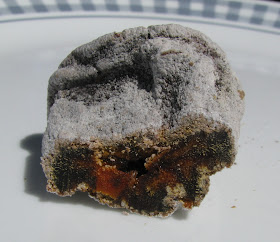Let me say that I am not a food expert. I wish I were, but I really just post here about things I've heard or read from what I think are legitimate sources. For example, for this post on dried persimmons, I'm not going to do much research because I just wanted to share how my family used to make dried persimmons. These pictured here my parents bought because we no longer dry them ourselves.
Anyway, Pinch My Salt posted about persimmons here and made me think about dried persimmons. I LOVE persimmons, or "kaki" (pronounced "kah-kee") in Japanese. Fresh ones and also when they're baked into persimmon cookies. One thing of which I'm not particularly fond are dried persimmons, although now that I've thought about it, they would be good chopped up and put in salads or something. So how did my mom's parents make them? It's kinda funny: You skin Hachiya (the acorn-shaped ones; not the pumpkin-shaped Fuyu ones) persimmons, tie them to strings, and hang them up to dry for days and days, "massaging" them every few days (that's my mom's term; they explain why here). Just on their own they turn ashy. Too bad I didn't take pictures when I was little. I saw those weird things hanging in the garage (not where cars were parked) often and didn't think much about them except for the fact that I used to like them and then started disliking them. Go here for another description and pictures of the drying process. I'm guessing that Grandpa dried them out in the sun during the day and then left them in the garage overnight.
So...what do they taste like? Depending on how long they've been drying and how long they've been dried, they are usually firm but slightly soft (some, like these here, are very hard), dry (obviously), dense, sweet, slightly cinnamon-y, chewy, and almost grainy with those thin strands of fibrous stuff that's naturally in the persimmon.



No comments:
Post a Comment